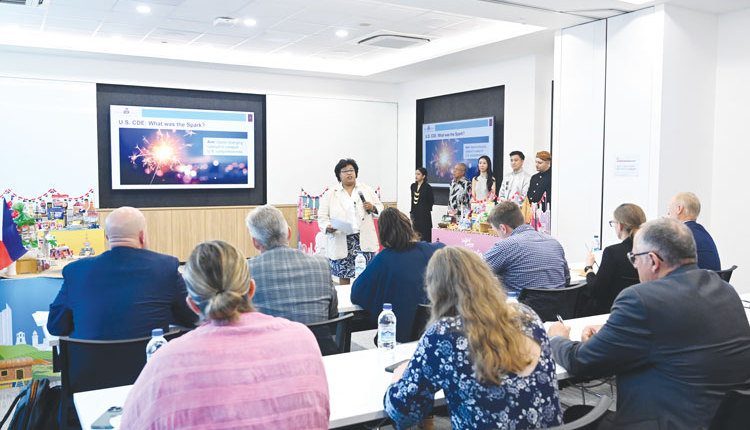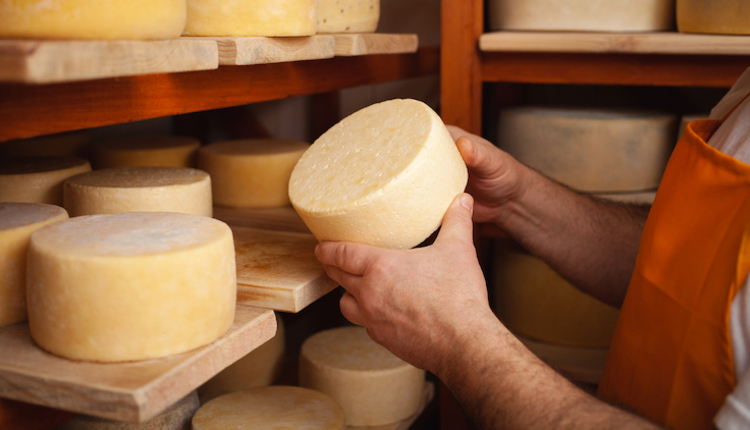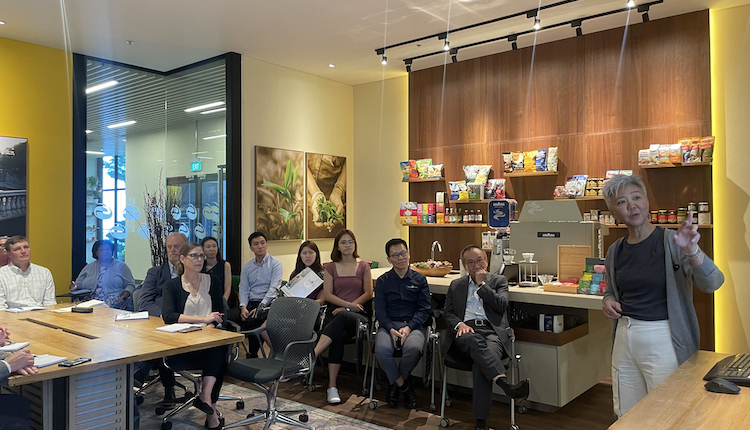
Consumers crave connection. So, how do you create that connection? Build a game-changing innovation center halfway around the world, find some of the best people to run it, and ultimately, create synergy between the U.S. and customers throughout Southeast Asia that builds dairy demand.
A delegation of U.S. dairy farmers and industry leaders from nine states saw, for the first time, the U.S. Center for Dairy Excellence (CDE) in action. Even though it was their first trip to Singapore to see the CDE due to the COVID-19 pandemic, the U.S. Dairy Export Council (USDEC) and its Center for Dairy Excellence has been yielding results for some time. That’s because dairy customers have been working with U.S. dairy industry’s flagship investment in Southeast Asia for over three years now . . . albeit on a virtual basis as the CDE opened just two weeks before the pandemic clamped down on global business.
The proof of progress
The United States held a 28% import market share in Southeast Asia in 2022, up nearly 5 percentage points since 2019. Keep in mind this growth took place even with headwinds such as supply chain logistics and port issues that made dairy product delivery a bit of a challenge to customers some 12 hours of time zone changes away.
Now that the CDE is fully open for business, the newfound interaction between U.S. dairy suppliers and their customers located on the other side of the globe will grow further as everyone creates synergy to incorporate great U.S. dairy ingredients and its healthy halo of nutrients into Southeast Asian foods.
The island nation of Singapore is an ideal location for the CDE as it’s easily accessible for many current and potential customers throughout the region. The region includes nearly 9% of the world population, and yet, some countries in the region produce less than 1% of their domestic needs.
The first believers
“This is the house that farmers built,” said Vikki Nicholson-West, USDEC senior vice president of Global Ingredients Marketing and executive director of USDEC Singapore Ltd (the latter is also known as the CDE).
“What was the impetus for putting the CDE together? What was that spark?” she asked, looking back rhetorically on the events that led to the CDE’s creation.
“Some of you may recall the Innovation Center for U.S. Dairy did a global study to determine what it would take to be competitive,” she reminded the U.S. farmer delegation. “One of those elements was customer centricity and really making sure the key elements were there about meeting customer needs, specifically in the form of real time, in-market presence by supporting the customer via technical support, customer support, or customer engagement,” said the 14-year USDEC staffer.
“In the spring of 2018, staff was tasked by USDEC senior leadership to answer these questions: ‘What can we do to really enhance our industry’s competitiveness? How can we help our members and our farmers to be more? What can we do to remove constraints?’” recalled Nicholson-West of those early meetings.
“The idea that we felt would be a game changer was having an embedded presence in the market,” the dairy ingredients strategist said of connecting the U.S. to potential customers. “So, from there, the journey for the U.S. Center for Dairy Excellence began.”
Finding a home
“We conducted a foundational study and asked ourselves, ‘What is the driver? What do we really need to be able to do? What will help drive this endeavor?’” shared Nicholson-West.
“Simultaneously, we also did a geographical study. Where is the best place to put this?”
“We also asked USDEC members, ‘What do you need in it? What do you not need in it?’ That was a critical piece in working with all our partners,” she shared.
“Initially, we looked at three geographical locations that included Dubai, Hong Kong, and Singapore. Based on the analysis that came back, the leading candidate was Singapore. The members really supported it, and it ultimately became a linchpin and a beachhead,” she said of Singapore, which is the regional trendsetter located nearly equidistant to many countries throughout the region. Then the game of finding an actual facility ensued.
“For Chuck and I, it was like house hunting on steroids,” she said of her partnership with teammate Chuck Timpko, USDEC senior vice president of operations and evaluation. “We had a business agency who helped us identify 66 sites that met key criteria, and we visited over two dozen all throughout Singapore.
“From there, it was really based upon a vision for the Center for Dairy Excellence. First, we wanted to build the first-of-its-kind learning facility — a destination hub for everything U.S. dairy. I’d like to say it’s akin to the ‘Disney of Dairy.’ It’s that gateway, that link connecting U.S. suppliers and our Southeast Asian customers,” she said. “It’s the place you want to go to learn and experience dairy. It’s also a place to meet health professionals, opinion leaders, and our partners within the region. Here we can develop locally tailored foods, beverages, menus, and innovative win-win solutions,” said Nicholson-West who has been with USDEC for half of its 28-year existence.
“Ultimately, it’s a home away from home for USDEC members and our farmers,” she said. Having a home nearly halfway around the world is critical as the Center allows the U.S. to interact with them on a personal basis during their business day,” she went on to explain.
“This is your place on the other side of the world that you can call home that represents U.S. dairy and all of its assets,” said Nicholson-West of the 5,400 square foot facility. To bring new food ideas to life, the CDE contains a demonstration kitchen to create foods, a sensory lab to test foods, a classroom training facility to explain dairy ingredients, and video-streaming capabilities to reach beyond its walls.
“Even though we opened our doors two weeks before the pandemic, the CDE accomplished everything it was meant to do from day one, only we did it virtually,” said Nicholson-West of the active engagement via webinars.
People bring it to life
“Another equally important aspect of this facility is the people that are in it,” shared Nicholson-West. “They are a critical asset to its success and bringing this all to life.”
“I was involved at the virtual grand opening, but it’s so much better seeing it in person,” said USDEC Board Chairman Larry Hancock of the CDE. “I am so impressed with the facility. However, I’m even more impressed with the people who are working here and their excitement for U.S. dairy,” continued the Texas dairyman. “They are great people, and they are working hard. They will sell more milk and expand our markets here,” he said of current and future work in Southeast Asia.
“The thing that impressed me most about coming to the CDE in Singapore is the enthusiasm and the professionalism of the staff here,” said Maine dairywoman Kate Fogler. “They are absolutely crazy about U.S. dairy, and they really want to help us move forward into the future.”
California’s Becky Nyman couldn’t agree more. “There is a very talented team that is very dedicated to helping our dairy industry,” said the Hilmar dairywoman. “They are a very high caliber group of people who are really looking out for dairy’s best interest.”
Creating Asian cuisine
“We don’t just promote ingredients, we promote innovation,” said Martin Teo, USDEC technical director, Food Applications, Southeast Asia. “We want people to succeed,” he said with the “people” being U.S. dairy product customers.
With that as the backdrop, Teo gave farmers a glimpse into the future.
“We (Southeast Asians) like a crispy and crunchy cookie. Protein crisps that are made up of casein and whey proteins are very popular. One potential product is a Crunchy Protein Mocha Bar,” shared Martin, who had a host of food product prototypes on display. “It contains dairy protein, chocolate, mocha, and almonds, and it creates a winning combination. Some have suggested to us to offer a caffeine-free variant to make it kid-friendly.”
“We believe the ‘High Protein Mango Pudding’ could become popular,” shared Anoo Pothen, USDEC director, Consumer Insights, Southeast Asia. “The benefits include quality dairy protein and reduced sugar content.”
Some other concepts being developed by the CDE team include a protein water enhanced with citrus ginger turmeric. To help develop a product to the liking of Southeast Asian consumers, acidified whey protein concentrate delivers the protein while allowing the citrus-ginger-turmeric flavored protein water to hold its yellow color. Another product ideation, “Honey Lemon Protein Water,” provided flavor Asian consumers cherish, and it also delivered 19 grams of protein per serving thanks to the addition of U.S. whey protein.
In the same vein, ginseng is a popular root plant incorporated into Asian cuisines. By adding milk protein concentrate and skimmed milk powder, USDEC food specialists married the great taste of ginseng with dairy’s high protein content.
Sodium levels that have climbed to 300% of the recommended daily allowance (RDA), in some cases, have also become a concern in the region. “Permeate, a high lactose dairy ingredient, has been a great replacement for salt in Southeast Asia diets,” said Teo.
“Cheese is not an inherent part of our diet. We need to show others how to use it,” Teo added of the kingpin of U.S. dairy products and the CDE’s efforts to connect with more customers.
“One of the most impressive things I saw at the U.S. Center for Dairy Excellence was how they were able to look at different ingredients and different ways to use dairy in forms that I never even thought,” said Marilyn Hershey, chair of the board of directors for Dairy Management Inc. (DMI) and a Pennsylvania dairy farmer. “It fits perfectly into the Singapore and Southeast Asia culture,” she said of the Center that helps educate customers about U.S. dairy ingredients and cheese and informs USDEC members about promising export growth opportunities throughout Southeast Asia.
“The most striking thing that I found at the Center for Dairy Excellence is our ability to find wide-ranging solutions for our customers,” said Missouri dairyman Alex Peterson, doubling down on the solutions the CDE can provide customers. “Whether it’s the test kitchen where we can come up with new formulations, the sensory lab to test those creations, or a space to host presentations or webinars, the CDE is a great place to connect with customers,” continued the USDEC vice chairman.
“The visibility for the U.S. Dairy Export Council is real,” said Daliah Ghazalay, USDEC regional director for Southeast Asia. “We are making good traction,” she said of the group’s work.
“You should take pride in nourishing the world,” Ghazalay said to the farmer delegation. “Sometimes we take for granted how many foods have U.S. dairy ingredients incorporated into them.”
At the same time, there are some hurdles to overcome.
Opportunity and hurdles
“The Association of Southeast Asian Nations (ASEAN) and some of its member states have free trade agreements with Oceania (Australia and New Zealand) and the European Union. The U.S. does not,” she said of continued long-term marketing obstacles in the region.
“If we are serious about exports in this region, we can’t just talk. We must do,” said U.S. Dairy Export Council (USDEC) CEO Krysta Harden of the new Center in Singapore. “On the ledger for the positives, we have so much going on for U.S. dairy,” shared Harden regarding the overall long-term view on U.S. dairy exports. Part of that “going on” is the six major countries of Southeast Asia growing to become the second largest dairy product customer for the collective U.S. dairy industry.
The Philippines leads the “six some” of countries and ranked No. 5 among all U.S. dairy customers. The Philippines, the world’s No. 13 country ranked by its population of some 117 million people, is among the world’s most dairy-deficit countries, producing less than 1% of its dairy product needs.
Standing at No. 7, No. 8, and No. 9 are Indonesia, Vietnam, and Malaysia, respectively. Thailand and Singapore rounded out the group of six major dairy product customers in Southeast Asia.
Positioned for the future
“The Center for Dairy Excellence (CDE) is right in the middle of 600 million people in Southeast Asia,” said Skip Hardie, who recently witnessed the CDE during a USDEC farmer trade mission in early June. “This center is a U.S. dairy farmer’s dream come true,” continued the New York dairyman. That dream is the ability to better connect with customers and grow U.S. dairy product and ingredient sales.
“Being a dairy farmer from Minnesota, I travel a lot around the United States. However, this is my first time outside of North America in my life,” said dairyman Charles Krause.
“Having the opportunity to come to Singapore and see the Center for Dairy Excellence is kind of overwhelming for me. I think back to my father and ask, ‘What would he have thought about the need for dairy exports?’” Krause considered about his late father, who once hauled milk to town in cans to be turned into dairy products for nearby residents.
“Coming to the Center for Dairy Excellence really opened my eyes to see the innovation, the way we are working with customers, and the way we are making that connection,” said a wide-eyed Krause. “We can have a great product, but if we don’t have a personal connection, that great product means nothing. The people who work for us at the Center for Dairy Excellence in Singapore are the ones who are getting that word across.”





